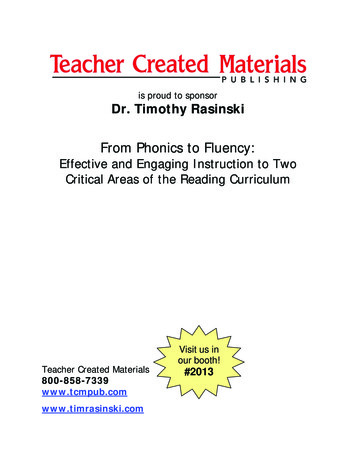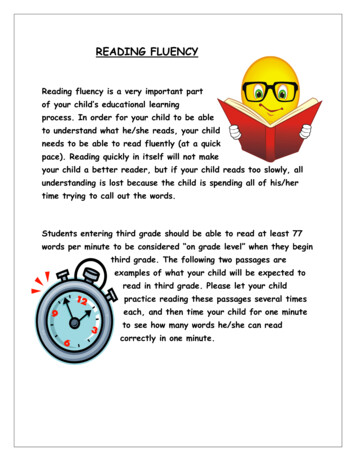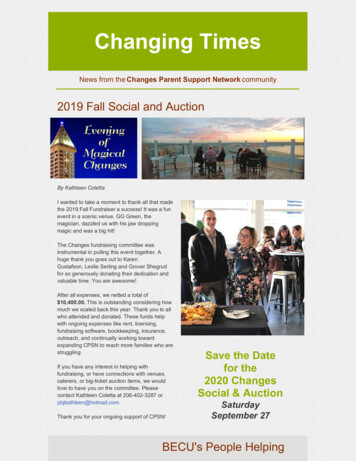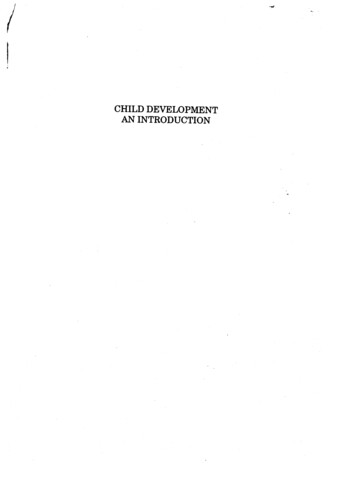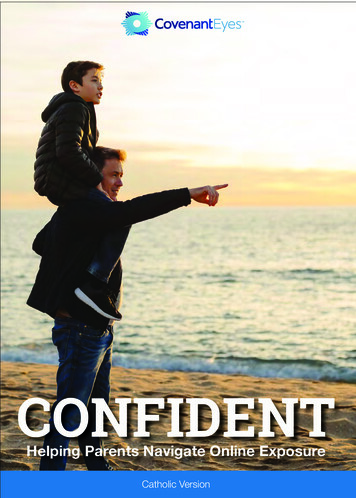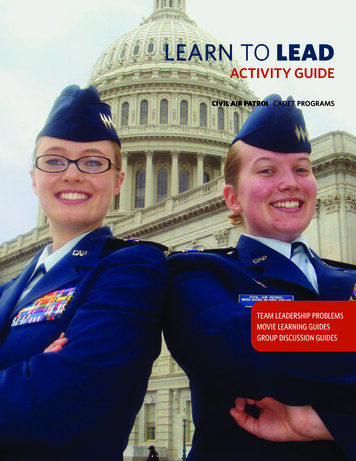
Transcription
HelpingYour ChildLearn History
U.S. Department of EducationRod PaigeSecretaryOffice of Intergovernmentaland Interagency AffairsLaurie M. RichAssistant SecretaryTo order copies of this publication in Englishor Spanish write to:ED PubsEducation Publications CenterU.S. Department of EducationP.O. Box 1398Jessup, MD 20794-1398;John McGrathSenior Director for Community Services,Partnerships and Recognition Programsor fax your request to: 301-470-1244;First published in May 1993.Revised in June 2004.or call in your request toll-free: 877-433-7827(877-4-ED-PUBS). If 877 is not yet available inyour area, call 800-872-5327 (800-USA-LEARN).Those who use a telecommunications device forthe deaf (TDD) or a teletypewriter (TTY), shouldcall 800-437-0833.This booklet is in the public domain.Authorization to reproduce it in whole orin part for educational purposes is granted.While permission to reprint this publicationis not necessary, the citation should be:U.S. Department of Education, Office ofIntergovernmental and Interagency Affairs,Helping Your Child Learn History,Washington, D.C., 2004.or e-mail your request to: edpubs@inet.ed.gov.or order online ingYour ChildLearn Historywith activities for children in preschool through grade 5This publication is also available on theDepartment’s Web site at:www.ed.gov/pubs/parents/hyc.html.On request, this publication is available inalternative formats, such as Braille, large print,or computer diskette. For more information,please contact the Department’s AlternativeFormat Center 202-260-9895 or 202-205-8113.Children’s books are mentioned in this booklet asexamples and are only a few of many appropriatechildren’s books. Other materials mentioned areprovided as resources and examples for the reader’sconvenience. Listing of materials and resources inthis book should not be construed or interpretedas an endorsement by the Department of anyprivate organization or business listed herein.U.S. Department of EducationOffice of Intergovernmental and Interagency Affairswith generous support from
ForewordContentsImagine that you wake up one morning to find out you have no memory! You’re notable to remember who you are or what happened in your life yesterday or the daybefore that. You’re unable to recognize your children, and you can’t communicate withneighbors and other people because you no longer know how to greet them, and youcan’t understand what they are saying. You don’t remember what the words “elections,”“wars,” or “movies” mean.Introduction . . . . . . . . . . . . . . . . . . . . . . . . . . . . . . . . . . . . . . . . . . . . . . . . . . . . . . . . . . . . . . . . . . . . . .1History Habits . . . . . . . . . . . . . . . . . . . . . . . . . . . . . . . . . . . . . . . . . . . . . . . . . . . . . . . . . . . . . . . . . . . . .1Enjoying History With Your Child . . . . . . . . . . . . . . . . . . . . . . . . . . . . . . . . . . . . . . . . . . . . . . . . . .3How to Use This Booklet . . . . . . . . . . . . . . . . . . . . . . . . . . . . . . . . . . . . . . . . . . . . . . . . . . . . . . . . . .4Some Basics . . . . . . . . . . . . . . . . . . . . . . . . . . . . . . . . . . . . . . . . . . . . . . . . . . . . . . . . . . . . . . . . . . . . . . .5What Is History? . . . . . . . . . . . . . . . . . . . . . . . . . . . . . . . . . . . . . . . . . . . . . . . . . . . . . . . . . . . . . . . . . .5A New Look at the Study of History . . . . . . . . . . . . . . . . . . . . . . . . . . . . . . . . . . . . . . . . . .7Geography: An Important Tool for Learning and Understanding History . . . . . . . . . . . . . .8Activities . . . . . . . . . . . . . . . . . . . . . . . . . . . . . . . . . . . . . . . . . . . . . . . . . . . . . . . . . . . . . . . . . . . . . . . . .10History as Story . . . . . . . . . . . . . . . . . . . . . . . . . . . . . . . . . . . . . . . . . . . . . . . . . . . . . . . . .11Listen My Children . . . . . . . . . . . . . . . . . . . . . . . . . . . . . . . . . . . . . . . . . . . . . . . . . . . . . . .12What’s the Story? . . . . . . . . . . . . . . . . . . . . . . . . . . . . . . . . . . . . . . . . . . . . . . . . . . . . . . . .14History Lives . . . . . . . . . . . . . . . . . . . . . . . . . . . . . . . . . . . . . . . . . . . . . . . . . . . . . . . . . . .16Cooking Up History . . . . . . . . . . . . . . . . . . . . . . . . . . . . . . . . . . . . . . . . . . . . . . . . . . . . . . .17Rub Against History . . . . . . . . . . . . . . . . . . . . . . . . . . . . . . . . . . . . . . . . . . . . . . . . . . . . . .20Our Heroes! . . . . . . . . . . . . . . . . . . . . . . . . . . . . . . . . . . . . . . . . . . . . . . . . . . . . . . . . . . . .22Learning How to Learn . . . . . . . . . . . . . . . . . . . . . . . . . . . . . . . . . . . . . . . . . . . . . . . . . . .23All About Our Town . . . . . . . . . . . . . . . . . . . . . . . . . . . . . . . . . . . . . . . . . . . . . . . . . . . . . .25In the Right Direction . . . . . . . . . . . . . . . . . . . . . . . . . . . . . . . . . . . . . . . . . . . . . . . . . . . .27What’s News? . . . . . . . . . . . . . . . . . . . . . . . . . . . . . . . . . . . . . . . . . . . . . . . . . . . . . . . . . . .29History on the Go . . . . . . . . . . . . . . . . . . . . . . . . . . . . . . . . . . . . . . . . . . . . . . . . . . . . . . . .31History as Time . . . . . . . . . . . . . . . . . . . . . . . . . . . . . . . . . . . . . . . . . . . . . . . . . . . . . . . .33School Days . . . . . . . . . . . . . . . . . . . . . . . . . . . . . . . . . . . . . . . . . . . . . . . . . . . . . . . . . . . .35Put Time in a Bottle . . . . . . . . . . . . . . . . . . . . . . . . . . . . . . . . . . . . . . . . . . . . . . . . . . . . . .37Quill Pens & Berry Ink . . . . . . . . . . . . . . . . . . . . . . . . . . . . . . . . . . . . . . . . . . . . . . . . . . . .39Time Marches On . . . . . . . . . . . . . . . . . . . . . . . . . . . . . . . . . . . . . . . . . . . . . . . . . . . . . . . .41The Past Anew . . . . . . . . . . . . . . . . . . . . . . . . . . . . . . . . . . . . . . . . . . . . . . . . . . . . . . . . . .43Weave a Web . . . . . . . . . . . . . . . . . . . . . . . . . . . . . . . . . . . . . . . . . . . . . . . . . . . . . . . . . . .44Time to Celebrate . . . . . . . . . . . . . . . . . . . . . . . . . . . . . . . . . . . . . . . . . . . . . . . . . . . . . . .46It’s in the Cards . . . . . . . . . . . . . . . . . . . . . . . . . . . . . . . . . . . . . . . . . . . . . . . . . . . . . . . . .48Working With Teachers and Schools . . . . . . . . . . . . . . . . . . . . . . . . . . . . . . . . . . . . .50Bibliography . . . . . . . . . . . . . . . . . . . . . . . . . . . . . . . . . . . . . . . . . . . . . . . . . . . . . . . . . . . . .55Resources . . . . . . . . . . . . . . . . . . . . . . . . . . . . . . . . . . . . . . . . . . . . . . . . . . . . . . . . . . . . . . .56Federal Sources of Information . . . . . . . . . . . . . . . . . . . . . . . . . . . . . . . . . . . . . . . . . . . . .56Web Sites . . . . . . . . . . . . . . . . . . . . . . . . . . . . . . . . . . . . . . . . . . . . . . . . . . . . . . . . . . . . . .57Publications for Parents . . . . . . . . . . . . . . . . . . . . . . . . . . . . . . . . . . . . . . . . . . . . . . . . . . .58Books for Children . . . . . . . . . . . . . . . . . . . . . . . . . . . . . . . . . . . . . . . . . . . . . . . . . . . . . . .59Children’s Magazines . . . . . . . . . . . . . . . . . . . . . . . . . . . . . . . . . . . . . . . . . . . . . . . . . . . . .70Acknowledgments . . . . . . . . . . . . . . . . . . . . . . . . . . . . . . . . . . . . . . . . . . . . . . . . . . . . . . .72Just as having no personal memory deprives us of a sense of our own identity, having nohistorical memory deprives us of a sense of our national identity and, in the words of Mrs.Lynne V. Cheney, noted author and wife of the vice president of the United States, of “aperspective on human existence.” Knowledge of U. S. history enables us to understandour nation’s traditions, its conflicts, and its central ideas, values and organizing principles.Knowledge of world history enables us to understand other cultures. In addition, withouthistorical memory, we miss a great source of enjoyment that comes from piecing togetherthe story of the past—our own, our nation’s and the world’s. Our historical memory isenriched by our understanding of geography, which lets us better see the physicalcontext of cultures and environments around the world and across time.Through the No Child Left Behind Act of 2001, President George W. Bush has made clear hiscommitment to the goals of raising standards of achievement for all children and ofproviding all children with highly qualified teachers and with instruction that is based onscientific research. Helping Your Child Learn History is part of the presidentÌs efforts toprovide families with the latest research and practical information that can help them tosupport their childrenÌs learning at home.By showing interest in their children’s education, families can spark enthusiasm in themand lead them to a very important understanding—that learning can be enjoyable as wellas rewarding and is well worth the effort required.We hope that you find this booklet a valuable tool for developing and reinforcing yourchild’s interest in and knowledge of history—and that you and your family may increaseyour appreciation for why such knowledge is important.iiHelping Your Child Learn HistoryHelping Your Child Learn Historyiii
IntroductionChildren are born into history. They have nomemory of it, yet they find themselves in themiddle of a story that began before they becameone of its characters. Children also want to have aplace in history—their first historical questionsare: “Where did I come from?” and “Was I alwayshere?” These two questions contain the two mainmeanings of history: It’s the story of people andevents, and it’s the record of times past. Andbecause it’s to us that they address these questions, we are in the bestposition to help prepare our children to achieve the lifelong task offinding their place in history by helping them learn what shaped theworld into which they were born. Without information about theirhistory, children don’t “get” a lot of what they hear and see around them.“A system of education that fails to nurturememory of the past denies its studentsa great deal: the satisfactions of maturethought, an attachment to abiding concerns,a perspective on human existence.”— Mrs. Lynne V. CheneyAuthor and Wife of U.S.Vice President Dick CheneyAlthough parents can be a positive force in helping their children developan interest in history, they also can undermine their children’s attitudesby saying things such as: “History is boring,” or “I hated history classwhen I was in school.” Although you can’t make your child like history,you can encourage her1 to do so, and you can take steps to ensure thatshe learns to appreciate its value.To begin, you can develop some of the following “history habits” thatshow your child that history is important not only as a school subject butin everyday life.History HabitsHabits are activities that we do on a regular basis. We acquire habits bychoosing to make them a part of our life. It’s worth the time and effort todevelop good habits because they enhance our well-being. The followinghistory habits can enrich your life experiences and those of your child.1. Please note: In this booklet, we refer to a child as “she” in some places and “he” in others. We do this to make the booklet easier to read.Please understand, however, that every point that we make is the same for boys and girls.ivHelping Your Child Learn HistoryHelping Your Child Learn History1
Share family history with your child, particularly your own memoriesof the people and places of your childhood. Encourage your parents andother relatives to talk with your child about family history.Read with your child about people and events that have made adifference in the world and discuss the readings together. (The list ofpublications in the Resources section at the end of this booklet can serveas a starting point for choosing materials.)Help your child know that the people who make history are realpeople just like her, and that they have ideas and dreams, work hardand experience failure and success. Introduce your child to local communityleaders in person if possible and to national and world leaders (both currentand those of the past) by means of newspapers, books, TV and the Internet.Watch TV programs about important historical topics with yourfamily and encourage discussion about the program as you watch. Checkout library books on the same topic and learn more about it. See if the booksand TV programs agree on significant issues and discuss any differences.Make globes, maps and encyclopedias (both print and onlineversions) available to your child and find ways to use them often.You can use a reference to Africa in your child’s favorite story as anopportunity to point out the continent on a globe. You can use the red,white and green stripes on a box of spaghetti to help her find Italy on a mapand to learn more about its culture by looking it up in the encyclopedia.Enjoying History With Your ChildAs a parent, you can help your child want tolearn in a way no one else can. That desire tolearn is a key to your child’s success, and, ofcourse, enjoyment is an important motivator forlearning. As you choose activities to do withyour child, remember that helping her to learnhistory doesn’t mean that you can’t have a good time. In fact, you canteach your child a lot through play. Here are some things to do to makehistory both fun and productive for you and your child:1. Use conversation to give your child confidence to learn.Encouraging your child to talk with you about a topic, no matter how offthe mark he may seem, lets him know that you take his ideas seriouslyand value his efforts to learn. The ability to have conversations with yourchild profoundly affects what and how he learns.2. Let your child know it’s OK to ask you questions.If you can’t answer all of her questions, that’s all right—no one has all theanswers. Some of the best answers you can give are, “Good question. Howcan we find the answer?” and “Let’s find out together.” Together, you andyour child can propose possible answers and then check them by usingreference books and the Internet, or by asking someone who is likely toknow the correct answers.3. Make the most of everyday opportunities.Check out from your library or buy a collection of great speechesand other written documents to read with your child from time to time.As you read, pause frequently and try to restate the key points in thesedocuments in language that your child can understand.2Helping Your Child Learn HistoryTake advantage of visits from grandparents to encourage storytelling abouttheir lives—What was school like for them? What was happening in thecountry and the world? What games or songs did they like? What werethe fads of the day? Who are their heroes? On holidays, talk with yourHelping Your Child Learn History3
Some Basicschild about why the holiday is observed, who (or what) it honors andhow and whether it’s observed in places other than the United States. Atball games, talk about the flag and the national anthem and what theymean to the country.4. Recognize that children have their own ideas and interests.By letting your child choose some activities that he wants to do, you lethim know that his ideas and interests have value. You can furtherreinforce this interest by asking your child to teach you what he learns.How to Use This BookletThe major portion of this booklet is made up of activities that you can usewith your child to strengthen his history knowledge and build strongpositive attitudes toward history. And you don’t have to be a historian orhave a college degree to do them. Your time and interest and the pleasurethat you share with your child as part of working together are whatmatter most. What’s far more important than being able to give your childa detailed explanation for the concepts underlying each activity is havingthe willingness to do the activity with him—to read, to ask questions, tosearch—and to make the learning enjoyable.In addition to activities, the booklet also includes: Some information about the basics of history; Practical suggestions for how to work with teachers and schools tohelp your child succeed in school; and A list of resources, such as federal sources of history, helpful Websites and lists of books for you and for your child.4Helping Your Child Learn HistoryWhat Is History?“Once upon a time . . . ” That opening for many favorite children’s talescaptures the two main meanings of history—it’s the story of people andevents, and it’s the record of times past. To better understand what historyis, let’s look closer at each of these two meanings.The Story in HistoryUnlike studying science, we study history without being able to directlyobserve events—they simply are no longer in our presence. “Doing”history is a way of bringing the past to life, in the best tradition of thestoryteller. We do this by weaving together various pieces of informationto create a story that gives shape to an event.There are many possible stories about the same event, and there are goodstorytellers and less good storytellers. Very rarely does one story say it allor any one storyteller “get it right.” A good student of history, therefore,tries to determine the true story by looking to see if a storyteller hasbacked up her story with solid evidence and facts.The history with which we are most familiar is political history—the storyof war and peace, important leaders and changes of government. Buthistory is more than that. Anything that has a past has a history, includingideas, such as the idea of freedom, and cultural activities, such as music,art or architecture.Helping Your Child Learn History5
Time in HistoryA New Look at the Study of HistoryTime in history is a kind of relationship. We can look at several eventsthat all happened at the same time and that together tell a story about aparticular part of the past. Or we can look at the development of an ideaover time and learn how and why it changed. We can consider therelationship between the past and the present, or the future and the past(which is today!). The present is the result of choices that people madeand the beliefs they held in the past.Studying history is more than memorizing namesand dates. Although it’s important for citizens toknow about great people and events, theenjoyment of history is often found in a “storywell told.” Here are some suggestions to make thestudy of history more enjoyable:As they prepare to study history, children first need basic knowledgeabout time and its relationship to change. They need to learn themeasures of time, such as year, decade, generation and century. And theyneed to learn and think about sequences of events as they occurred intime. They need to be able to ask, “About when did that happen?” and toknow how to find the answer.The main focus of history is the relationship between continuity andchange. It’s important, therefore, that our children understand thedifference between them. For example, the population of the UnitedStates has changed greatly over time with each wave of immigration. Asnew groups of immigrants entered American society, they brought alongideas, beliefs and traditions from their native lands. These new culturesand traditions were woven into existing American culture, contributing toits pattern of diversity and making our democratic system of governmenteven stronger. That system continues to evolve to better realize its originalpurpose of safeguarding our basic human rights of freedom and equalopportunity.6Helping Your Child Learn HistoryOriginal sources make history come alive.Reading the actual words that changed the courseof history and stories that focus on the details of time and place helpschildren know that history is about real people in real places who madereal choices that had some real consequences, and that these people couldhave made different choices.Less can mean more. An old proverb tells us that, “A well-formed mindis better than a well-stuffed mind.” Trying to learn the entire history ofthe world is not only impossible, it discourages children and reduces theirenthusiasm for history. In-depth study of a few important events givesthem a chance to understand the many sides of a story. They can alwaysadd new facts.History is hands-on work. Learning history is best done in the sameway that we learn to use a new language, or to play basketball: we do it aswell as read about it.“Doing history” means asking questions about events, people and places;searching our towns for signs of its history; talking with others aboutcurrent events and issues; and writing our own stories about the past.Helping Your Child Learn History7
Children do well to ask “So what?” Much that we take for granted isnot so obvious to children. We need to clarify for them the reasons we askthem to remember certain things. They need to know why it’s importantto get the facts right. Encouraging children to ask, “So what?” can helpthem understand what’s worth knowing—and why—and so help buildcritical thinking skills. Being able to think critically prepares children to judge the value of historical evidence; judge claims about what is true or good; be curious enough to look further into an event or topic; be skeptical enough to look for more than one account of an event orlife; and be aware that how we look at and think about things are oftenshaped by our own biases and opinions.make a lake, using sticks for bridges. The children name the streets, andthey may even use a watering can to make rain that washes away ahouse. They may not realize it, but these children are learning some corefeatures of geography—how people interact with the Earth, how climateaffects land, and how places relate to each other through the movementof things from one place to another. When we turn to maps or globes aswe talk with our children about vacation plans, events happening aroundthe world or historical events, we teach them a great deal aboutgeography. Not only can such activities help our children learn how to usekey reference tools, but over time, they help them form their own mentalmaps of the world, which allows children to better organize andunderstand information about other people, places, times and events.Geography: An Important Tool for Learning andUnderstanding HistoryGeography affects history—just look at the dramatic changes in worldgeography over recent years. Governments change, and new countries areborn. Many countries no longer have the same names they did even fiveyears ago. Climate changes bring about events such as droughts and floodsthat cause massive loss of life and migrations of people from one place toanother in search of safety. Environmental changes can change the entirehistory of a community or region.As with history, children have a natural interest in geography. Watch agroup of children playing in the sand. One child makes streets for his cars,while a second child builds houses along the street. A third scoops out ahole and uses the dirt to make a hill, then pours water in the hole to8Helping Your Child Learn HistoryHelping Your Child Learn History9
ActivitiesThe activities in this section are arranged into two groups that reflect themeanings of history as story and time. Each group is preceded by a reviewof three elements of story and time from the perspective of history. Thereview is meant to give you information that can support your conversations with your child as you do the activities.For each activity, you’ll see a grade span—from preschool through grade5—that suggests when children might be ready to try it. Of course,children don’t always become interested in or learn the same things at thesame time. And they don’t suddenly stop enjoying one thing and startenjoying another just because they are a little older. You’re the best judgeof which activity your child is ready to try. For example, you may findthat an activity listed for children in grades 1 or 2 works well with yourpreschooler. On the other hand, you might discover that the same activitymay not interest your child until he is in grade 3 or 4.In a box at the end of each activity, you’ll find questions to ask your childabout some part of the activity. These questions help your child developthe critical thinking skills he’ll need to participate well in society, learnhistory and learn from history.When you choose or begin an activity, keep in mind that the reason fordoing it is to help your child learn something about history. Whatever thespecific purpose of the activity, make sure that it’s clear to your child. Theinformation in the introduction and the questions for each activity canhelp you do this. After you complete each activity, discuss with your childwhat they learned. For example, making bread is one thing, recognizingbread’s historical meaning is another. An added bonus: achieving a goalyou set together at the beginning of an activity gives your child thepleasure of a completed project.10Helping Your Child Learn HistoryThe materials you need for these activities are found around most homes.Before starting the activities, give your child a notebook—a history log—inwhich he can record his own ideas and opinions about each activity. Ifyour child can’t yet write, encourage him to draw pictures of what hesees, or tell you what to write for him. In addition, you may want to keepa camera nearby so that your child can include photographs in his historylog. You may also wish to have him decorate and label a shoebox to usefor keeping history-related items and project materials.Finally, feel free to make changes in any activity—shorten or lengthen it—to suit your child’s interests and attention span.We hope that you and your child enjoy the activities and that they inspireyou to think of additional activities of your own. Let’s get started!History as StoryThe essential elements of history as story are records, narration and evidence.RecordsHistory is a permanent written record of thepast. In more recent times, history is alsorecorded on film, video, audiotape andthrough digital technology. You might tellyour child that the time before we had anyway to record events is called prehistory. Itwas in prehistorical times that dinosaurswalked the Earth. She should also know thatbefore written languages were invented, humans told stories as a way topreserve their identity and important events in their lives. Over time,however, the stories changed as details were forgotten or altered to fit aHelping Your Child Learn History11
new situation. Written languages allowed people to keep more accuraterecords of who they were and what they did so this information could bepassed down from generation to generation.NarrationNarration is storytelling, a way that people interpret events. History, withits facts and evidence, is also an interpretation of the past. GeorgeWashington, in his Farewell Address in 1796, said: “Though in reviewingthe incidents of my administration I am unconscious of intentional error, Iam nevertheless too sensible of my defects not to think it probable that Imay have committed many errors.” Your child needs to be aware thatevents can have more than one cause and can produce more than oneeffect, or outcome, and that there is more than one way to look at therelationship between cause and effect.What You NeedPicture and read-aloud books about historical people, places and eventsor with historical settings. For possible titles, see the list of books underthe Books for Children heading of the Resources section at the end ofthis booklet.What to Do —As you read, stop occasionally and ask your child to talk about acharacter or what is happening in the book. Encourage her to askyou questions if she doesn’t understand something. Explain wordsshe may not know and point to objects that she may not recognizeand tell her what they are.—Show enthusiasm about reading. Read the book with expression.Make it more interesting by talking as the characters would talk,making sound effects and using facial expressions and gestures.EvidenceAll good histories are based on evidence. Your child needs to learn theimportance of evidence, and she needs the critical thinking skills to evaluatehistorical accounts and to determine whether the they are based on solidevidence or rely too heavily on personal interpretation and opinion.Listen My ChildrenPreschool–Grade 1A great way for young children to develop an interest in history is for parentsto make books with history themes a part of their reading-aloud routines.12Helping Your Child Learn HistoryTalk with your child about the book you’re going to read to her. Haveher look at the pictures and notice costumes, types of transportation,houses and other things that show that the book isn’t about moderntimes. Talk with her about history—the story of past times. Help your child develop a “library habit.”Begin making weekly trips to the librarywhen she is very young. See that she getsher own library card as soon as possible.Many libraries issue cards to children assoon as they can print their names (you’llalso have to sign for your child).Regularly choose books with historythemes to check out and read at homewith her. And, when she is old enough,encourage her to continue this habit.Helping Your Child Learn History13
After reading a book with a historical theme, encourage your child tomake up a play for the family based on the book. If possible, allowher to wear a costume or use props that are mentioned in the story.“Remember the time that Uncle Jack decided to help us by fixingthat leaky faucet in our kitchen
In fact, you can teach your child a lot through play. Here are some things to do to make history both fun and productive for you and your child: 1. Use conversation to give your child confidence to learn. Encouraging your child to talk with you about a topic, no matter how off the mark he may seem, lets hi


